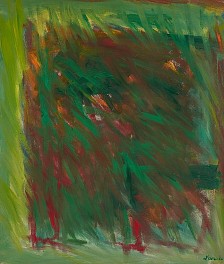BIOGRAPHY

American, 1907-1985
Like many of his peers--including de Kooning, Pollock, Rothko and others--Loew painted in a figurative style before the war and participated in the WPA mural project which gave otherwise unemployed artists jobs during the Great Depression. When he returned from WWII in 1946, his painting moved quickly toward abstraction. From 1947-1949, he studied post-Cubism at the Hans Hofmann School of Fine Arts. In 1948, he joined the Spiral Group, an organization of artists devoted to the exhibition of experimental art. The Artists Gallery in New York hosted his first one-man show in 1949.
Despite their opposing approaches to abstraction, Loew became a longtime friend of Willem de Kooning, whom he met completing WPA projects during the 1930s. Critic Rose C. S. Slivka observed, "They [de Kooning and Loew] generally agreed on most things, including the recognition that although each was on opposite sides of the coin, it was the same coin. 'Your work,' said Michael Loew to Willem de Kooning, 'is the lyrical grid.' 'And yours,' said Willem to Loew, 'is the song that breaks bars. I could learn plenty from you.'" ("Willem de Kooning," Art Journal, Fall 1989: pp. 219-221.)
Michael Loew was known for expressive abstract paintings that were based on the geometry and syntax of Neo-Plasticism. By enabling his boxes of color to float and by composing his grids with an increasing variety of rhythms and textures, he attempted to extend the achievement of Piet Mondrian in a more personal and lyrical direction.
Loew used the grid-structure of Mondrian as a base from which to experiment with the possibilities of the palette; to focus on subtle transitions of tone or harmony of color relationships. Drawing inspiration from life, he transformed subjects into unique patterns of rectangles or color fields, naming the final composition according to the dominant colors. He exhibited these works at the Stable Gallery Annuals, beginning a full and successful exhibition career.
In 1957, Loew participated in the International Assoc. of Plastic Arts Touring Exhibition, Contemporary American Painting as juror and exhibitor. Here he exhibited alongside Milton Avery, Samuel Adler, Josef Albers, de Kooning, Reinhardt, Walkowitz and others. The same year he gained representation at Zabriskie Gallery, next to Johns, Motherwell, and Rauschenberg. A recognized pillar of American Modernism, Loew maintained an active teaching and exhibition schedule until his death in 1985.
His work is in the collections of the Whitney Museum of American Art, the Hirshhorn Museum, the Philadelphia Museum of Art and the Museum of Modern Art, Carnegie Institute, in Pittsburgh, among others.
